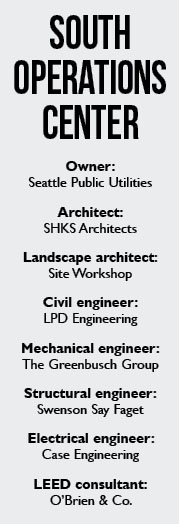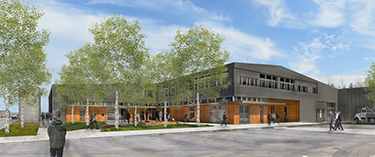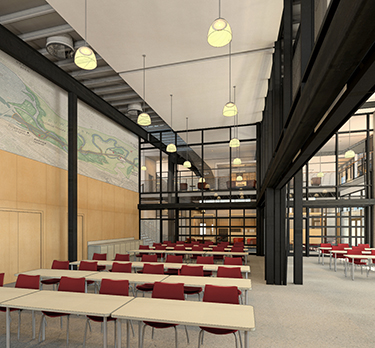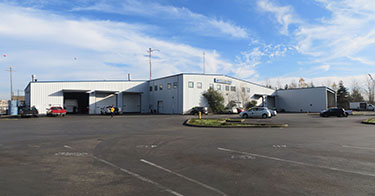|
Subscribe / Renew |
|
|
Contact Us |
|
| ► Subscribe to our Free Weekly Newsletter | |
| home | Welcome, sign in or click here to subscribe. | login |
Construction
| |
 |
March 29, 2018
SPU remodel shows even industrial buildings can be green
SHKS Architects

Westen
|
Utilitarian buildings on brownfield sites can perform at high levels and improve cities at their industrial margins. The Seattle Public Utilities drainage and wastewater South Operations Center is designed to demonstrate this.
A 38,000-square-foot pre-engineered metal building on the operation center’s 6-acre site will be substantially altered to create its new home.
The property, located on the western bank of the Duwamish River in West Seattle, has seen a variety of industrial uses over the years — including a shipbuilding yard, steel mill, lumber mill and, most recently, a Greyhound bus base — that have left their mark on the landscape.
This project will optimize operations, taking advantage of location, program efficiency and the transformation of operational processes. Site and program sensitivity demand a high level of environmental resilience. Additionally, the project will seek LEED gold certification.
Green site impacts
While the facility’s industrial location accommodates operational and program needs, achieving many of LEED’s sustainable sites credits is a challenge.
These credits commonly depend on compact development, alternative transportation and connection with amenities like restaurants and schools — elements not typically available in industrial zones. While LEED’s rating system would not encourage the selection of this site, there is inherent value in renovating buildings and brownfield sites like this one.
For SPU, proximity to the Duwamish River alone improves service. The utility manages wastewater and stormwater services for residences and businesses. Field employees clean and repair sewer and drainage systems, investigate waterway pollution, and provide emergency response to natural events and disasters throughout the city.
The center’s location on West Marginal Way will complement SPU’s other operational facilities and provide greater proximity to service areas. Additionally, it will provide critical access to West Seattle, a part of the city largely cut off from the utility’s emergency operations at times when the West Seattle Bridge is impassible.
This location will also significantly reduce drive time for field crews, which now operate out of SPU’s Charles Street complex in Sodo. The reduced drive time will decrease the fleet’s environmental impact.
Considering all aspects of a site and its environmental and operational benefits allows for critical efficiencies not always measured or rewarded by today’s green building rating systems.
Shared space
The center will accommodate field and office employees and co-locate SPU’s source control, planners and warehouse staff and city fleet maintenance. Shared operational spaces like decontamination, locker rooms and dispatch will decrease the overall space needs for the facility.

Co-locating multiple SPU divisions will encourage collaboration between groups and further decrease space needs by providing shared meeting, breakout and ancillary spaces. The inclusion of warehouse and city fleet maintenance staff on the site will decrease drive time for field crews and reduce breakdown time of fleet vehicles by having repair and maintenance staff on site.
Co-locating SPU departments and eliminating duplicate spaces will reduce the required floor area by approximately 8,000 square feet. These program efficiencies will result in a reduction of nearly 720,000 kilo-British thermal units of energy use annually. The projected energy use intensity is 90, much better than one would expect to see at an average facility of this type.
Managing runoff
The existing site is largely paved and located on non-native fill; rainwater cannot infiltrate to the subsurface. Consequently, the site produces stormwater runoff that, along with its pollutants, flows into the Duwamish River.
SPU will use multiple on-site cisterns to collect rainwater runoff from the roof. The stored rainwater will be used by crews to reduce potable water use both in the field and in on-site operations.
Field crews will be able to fill the 1,100-gallon vacuum extractor trucks with the collected rainwater and use it for tasks that don’t require potable water, such as cleaning and maintaining sewer and drainage systems. On site, the collected rainwater will be filtered and treated to be used to wash fleet vehicles.
This innovative use of rainwater — it was first proposed by an SPU staff member — improves the environmental impact of an industrial site not well suited for typical stormwater management strategies. To complement the reduction of stormwater runoff that the cisterns achieve, the site design includes vegetated biofiltration areas that treat stormwater before it enters the Duwamish.
Overall, optimization of outdoor elements such as storage and fleet parking will allow the site’s vegetated surface area to increase by 300 percent, including 73 new trees, all working to improve on-site stormwater management and occupant health.
Designed for resilience
As a tertiary emergency facility, the South Operations Center will be a dispatch center for drainage and wastewater emergency operations following a major storm, earthquake or other natural event.
The resilience of the building to withstand such events and be operational is critical. Projected sea level rise and river flooding frequency over the next 50 years pose unique design challenges for a site predicted to see regular annual flooding as early as 2033.
With resilience as an essential design principle, the design team explored elevating the floor above the existing slab to keep the building above most predicted flood levels. The new floor assembly layers 4 inches of concrete topping slab and 8 inches of rigid insulation over the existing structural slab.
The additional 12 inches of floor elevation delays the predicted annual flooding of the building until 2056, but also creates a space for the distribution of plumbing, data and electrical systems without complex cutting and patching of the existing structural slab.
This strategy will also result in significantly less slab demolition. The challenge of designing for resilience has proven to provide benefits in unexpected areas.
Reuse of an existing steel frame is a first step toward carbon reduction. Increasing pervious surface on an industrial site will improve site drainage and water quality.
The aggregation of small steps toward resource conservation and energy performance in the South Operations Center demonstrate that even utilitarian buildings on industrial sites can achieve high performance and improve our cities at their industrial margins.
Pia Westen is an associate with SHKS Architects and member of the University of Washington’s Carbon Leadership Forum. SHKS focuses on the sustainable renovation, repair and adaptation of buildings and sites for contemporary use.
Other Stories:
- Let’s make buildings people can still use after a disaster
- New green rating systems go way beyond LEED
- How cleaner indoor air makes for healthy workers and a healthier bottom line
- Cheap solar energy won't end the need for deep-green buildings
- To meet green goals, cities must grow more strategically
- Asphalt: the go-to material for green paving projects
- Climate change is making resilience a more urgent design priority
- We designed our own net-zero office — and you can, too
- Why we can’t reach our emissions goals without tracking embodied carbon





